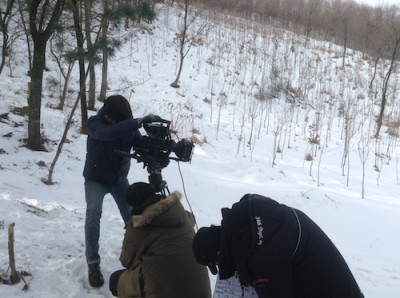Arpa Film Festival 2015 interviews with film directors
Sharon Swainson, writer for the Arpa International Film Festival, conducted separate interviews with Minji Kang, director of The Loyalist, and Younsik Kim, director of The Story of Snow. Both South Korean films will be screened at the Egyptian Theatre in Hollywood on Saturday, November 14. The directors’ candid responses are below.
THE LOYALIST
A North Korean general checks in on his daughter at a Swiss boarding school to test her loyalty to her motherland.
Why did you choose to make your film?
I wanted to tell a story about a father and daughter who, because of their North Korean nationality, do not have the choices that most of us do in more democratic societies. Also, similar to myself, I have been an international student for about 15 years, since leaving home at the age of 15. The story depicts a tormented young woman who stands with one foot in the East and the other in the Western world. Most importantly, I found myself deeply drawn to this unique father and daughter story, because the story reflects the continuous tragic reality of the Korean peninsula, which despite deep family ties, remains painfully divided by irreconcilable ideologies.
Name a moment during shooting that made you proud.
When I felt that the production was running on a strong trust platform, with the same driven goal, making The Loyalist as best we possibly could. Because in filmmaking nothing is more important than creative collaboration.
 Was there a moment that became a creative breakthrough while making your film?
Was there a moment that became a creative breakthrough while making your film?
In the beginning of preproduction, we had a difficult time finding the right location, especially the cabin where the second half of the film is shot. However, we got extremely lucky to find a cabin in Lake Placid, NY — only two weeks before filming. Finding the right location really sparked our imagination for the film.
During the creative process, was there a moment when you let go of certainties and just ran with it, allowing creativity to do its thing?
Of course. Although I walk onto the sets with clear, wild visions and propositions, I always welcome the serendipity happening in every frame, second, and minute as we travel through the filming and editing process — without it, the film will not contain magical sensibilities.
Since an artist is truly never finished, is there anything that you would like to do differently or add to your film?
 Sure, there is always something new I learn every time I complete a film. However once I deem it finished, I don’t go back; but I apply everything I wish to do differently or add to my next film(s). Perhaps this is why I’m eager to keep creating.
Sure, there is always something new I learn every time I complete a film. However once I deem it finished, I don’t go back; but I apply everything I wish to do differently or add to my next film(s). Perhaps this is why I’m eager to keep creating.
What does it mean to you to have your film selected by the Arpa International Film Festival?
It’s truly an honor to have such wonderful screening opportunities along with progressive films from all around the world. I was intrigued by the Arpa International Film Festival’s dedication to “cultivating global empathy, the cultural diversity.” The world is getting smaller and becoming a global society. Through unique and diverse films, it is important to understand different cultures and to be aware of the difficulties each country faces in this changing world.
THE STORY OF SNOW
Out of his dark basement and embarking on his last trip, a man walks towards snow capped mountains and encounters unexpected situations where he decides to die. This film follows the last day of his life from an external point view.
Why did you choose to make your film?
I think films are a means of communication for society, and are needed. Even at this moment, many people are dying and each death saddens us all. But the biggest anguish is when children passing away before their parents. As a father, before a director, I wanted to comfort them through this film. So, this film, The Story of Snow, is made not only to comfort parents who lost their kids, but also to remind others of their indifference to the incident well after it.
The word “widow” means a wife who lost her husband. The word “widower” means the husband who lost his wife. The word “refugee'”means a person who lost their country. The word “orphan” means a child who lost a parent. However, there is no word for a parent who lost a child. The reason is that there is not one word that can comfort them. This movie is dedicated to parents who have watched their children depart from this world.
Name a moment during shooting that made you proud.
 In South Korea, there are certain areas that do not have a lot of snow, and yet, more than half of the my film had to be shot on snow-capped mountains. The mountain that the protagonist climbs up actually ended up being 10 different shooting locations, because the snow melted at the shooting sites. In short, this shoot was a fight to capture in the slippery snow and the windy, cold weather.
In South Korea, there are certain areas that do not have a lot of snow, and yet, more than half of the my film had to be shot on snow-capped mountains. The mountain that the protagonist climbs up actually ended up being 10 different shooting locations, because the snow melted at the shooting sites. In short, this shoot was a fight to capture in the slippery snow and the windy, cold weather.
However, the most difficult scene to shoot was the hanging in the trees. The car could not ascend the mountain, so the staff had to climb to the top of a mountain, carrying portable generators and specialized equipment. Then we had to wait a few hours for the red sun to appear, because I wanted to shoot the two protagonists with the red sun behind them. It was worth it.
Was there a moment that became a creative breakthrough while making your film?
I think the most creative scene is the black screen with silence. This scene appears when the main character tries to commit suicide. When the main character dies in the scene, I wanted the audience to be buried in the same darkness as the character. The heavy “silence” makes everything feel like it’s the end! Ultimately, I wanted the audience to experience the same death as the main character. That’s why there is 15 seconds of silence — to allow the audience to experience the most important moment of sympathy for the main character.
Another important moment was to determine the ending scene in the movie. I was inspired by my 6 years old son. Before I departed on a business trip, my son gave me a toy. At first I did not know the meaning of him giving me a toy. I thought it was just a game. One day, I asked why he gave me the toy. His eyes were sad when he said, “When we’re far apart, I am afraid you will forget to remember me.” Thanks to my son, the last scene in the movie, at the Woodland Burial Place, has a toy on the dead son of the protagonist.
During the creative process, was there a moment when you let go of certainties and just ran with it, allowing creativity to do its thing?
 A typical film should strive to immerse the audience, be full of witty dialogue, brilliant mise-en-scène and camera work, and have attractive characters. However, my film does not persuade the audience to like the main character. In short, the film is deliberately unkind to the audience, evoking difficult self-reflection about when and if they sympathized with the main character.
A typical film should strive to immerse the audience, be full of witty dialogue, brilliant mise-en-scène and camera work, and have attractive characters. However, my film does not persuade the audience to like the main character. In short, the film is deliberately unkind to the audience, evoking difficult self-reflection about when and if they sympathized with the main character.
Since an artist is truly never finished, is there anything that you would like to do differently or add to your film?
Without hesitation, I would want to make the black screen with silence scene even more disturbing for the audience, because I want to give them time to reflect on their indifference to others’ sorrow.
What does it mean to you to have your film selected by the Arpa International Film Festival?
It has been 20 years since I started studying cinema. I am now 40 years old. In Korea, a 40-year-old is called,”Bulhok,” which means that one does not waver under any temptation. My film has been selected in the Arpa International Film Festival, so now I may have an opportunity to make another movie with more confidence. Thanks for selecting my film.
 Written by Sharon Swainson
Written by Sharon Swainson
Communications & Content Development
2015 Arpa International Film Festival


